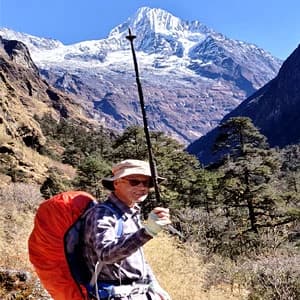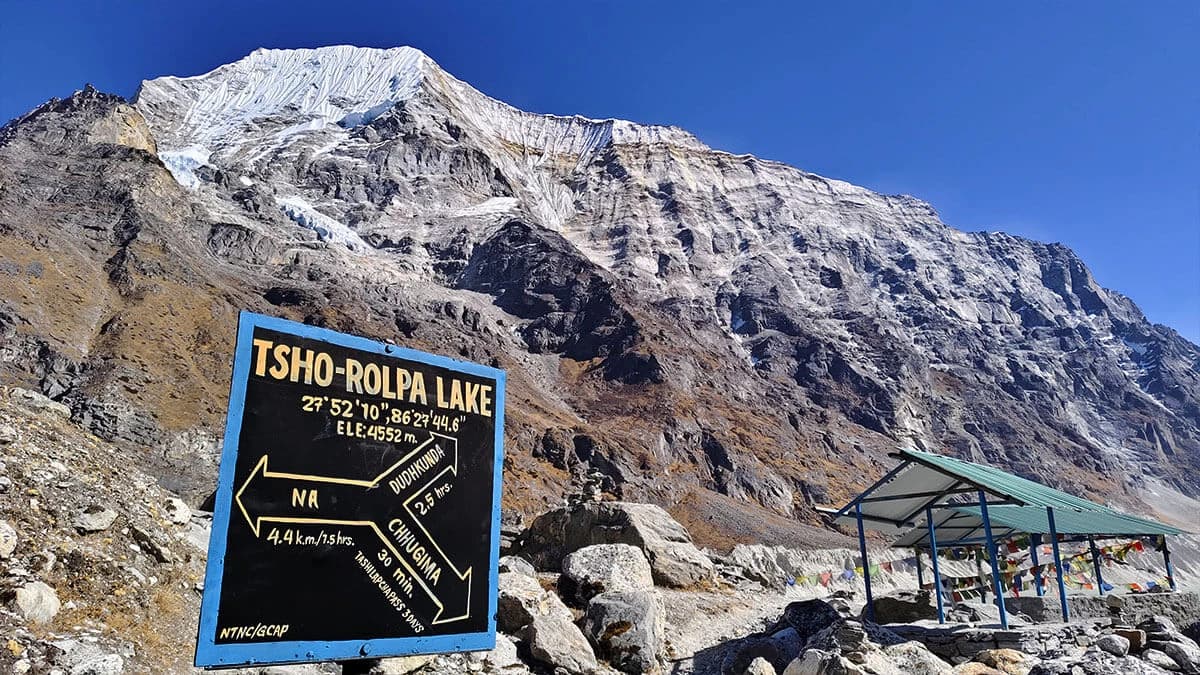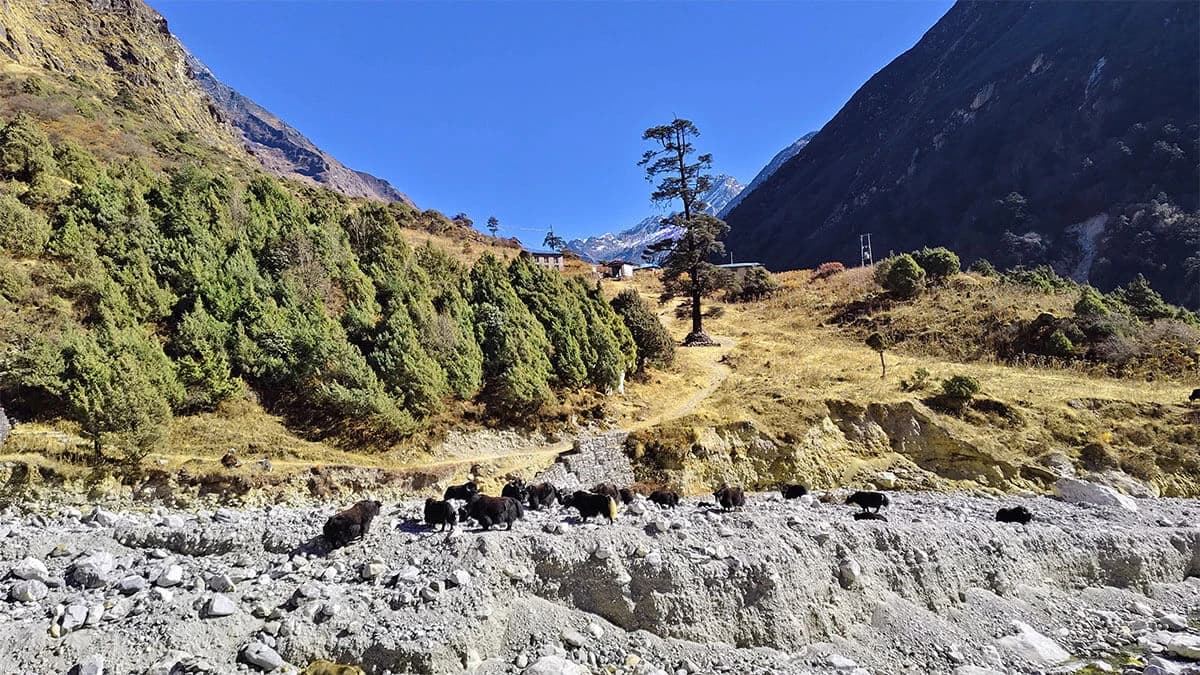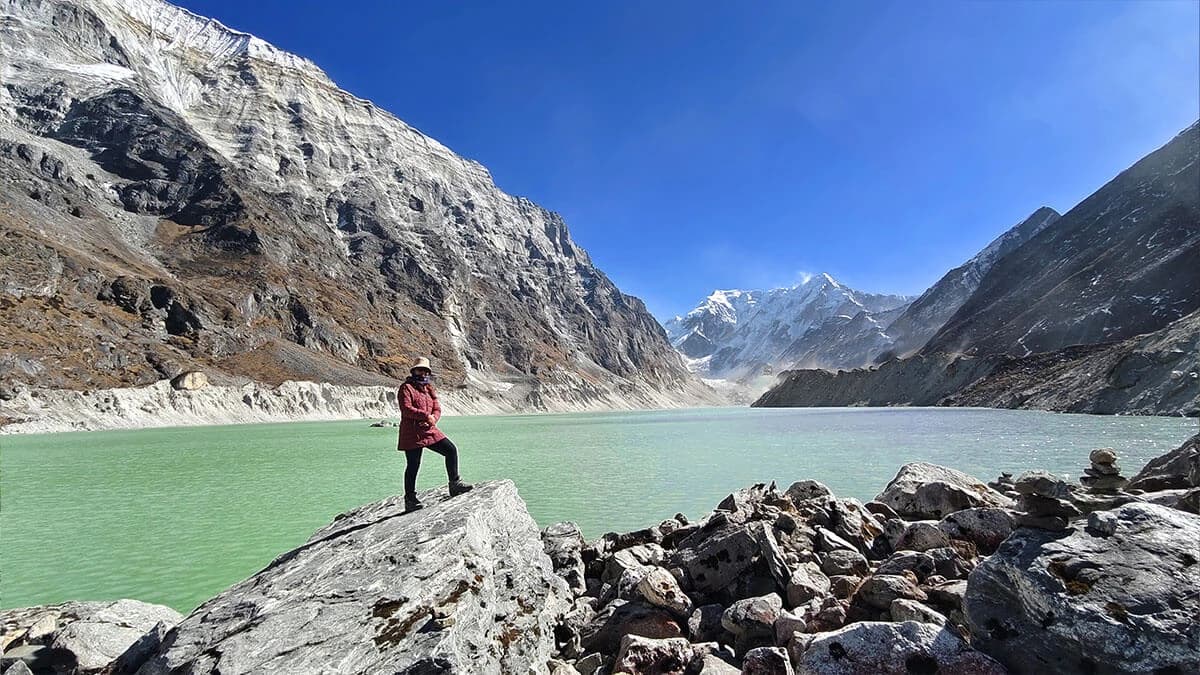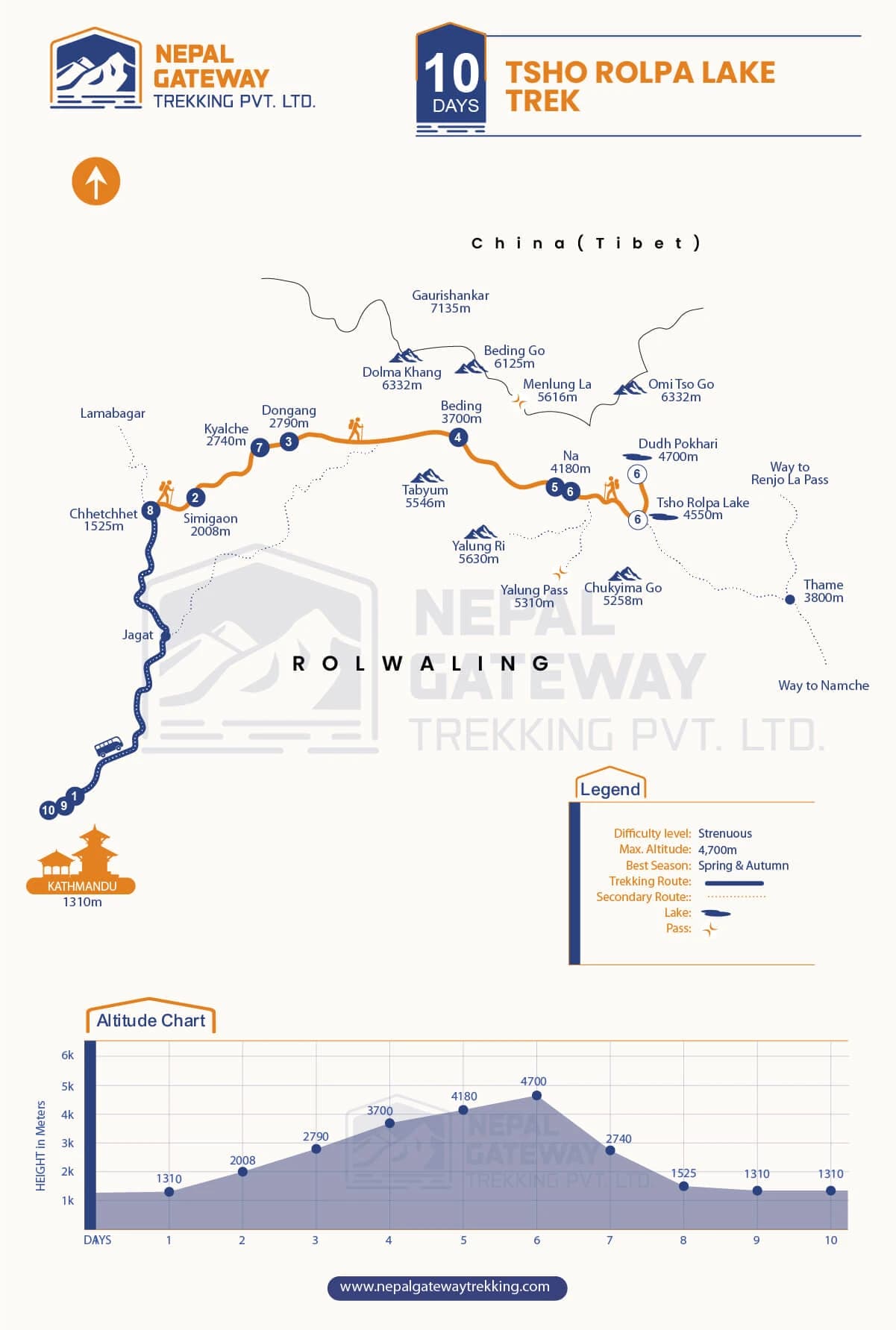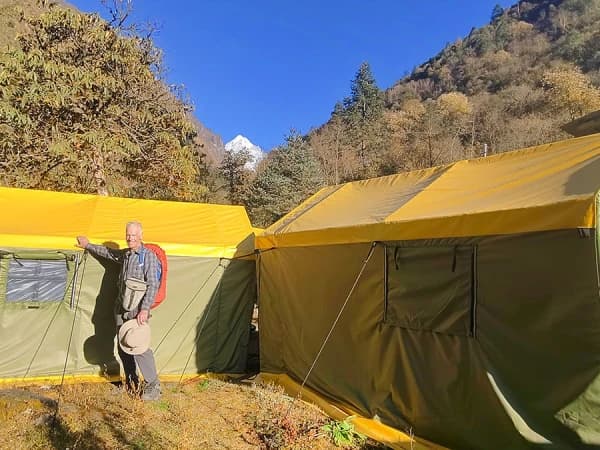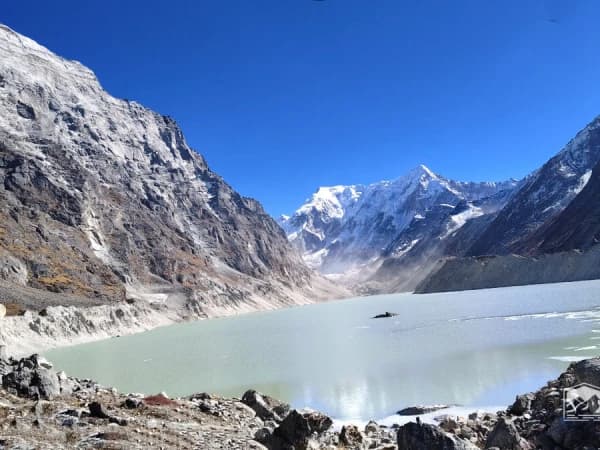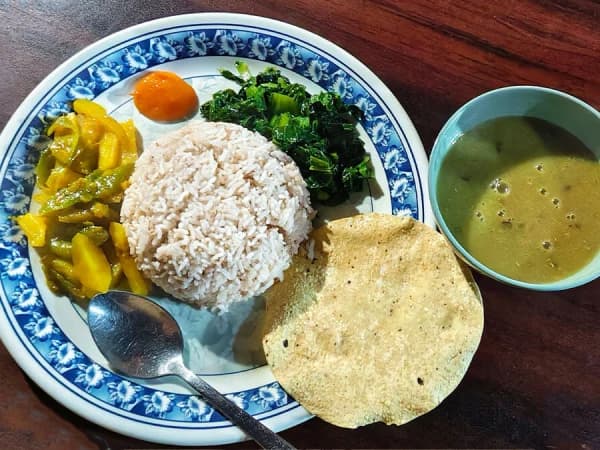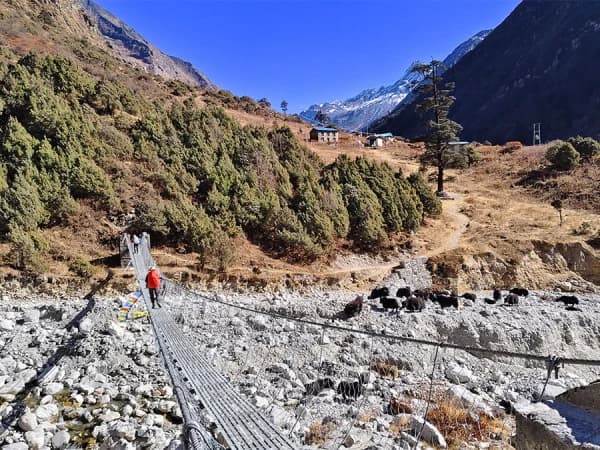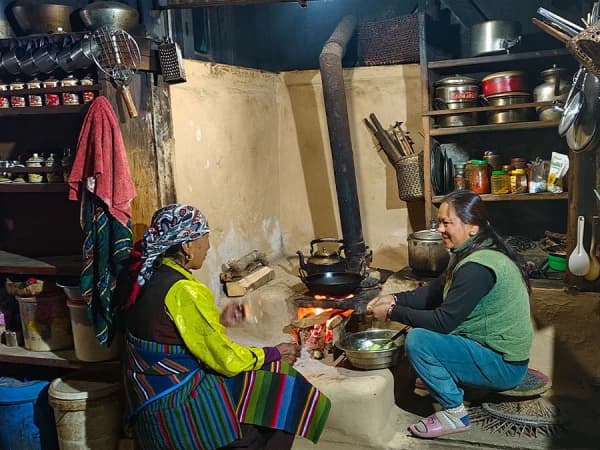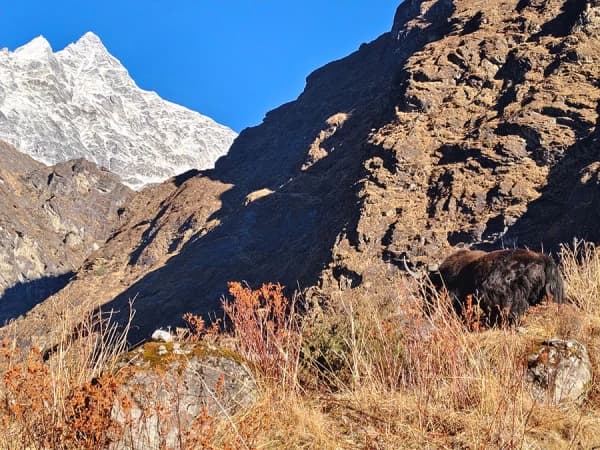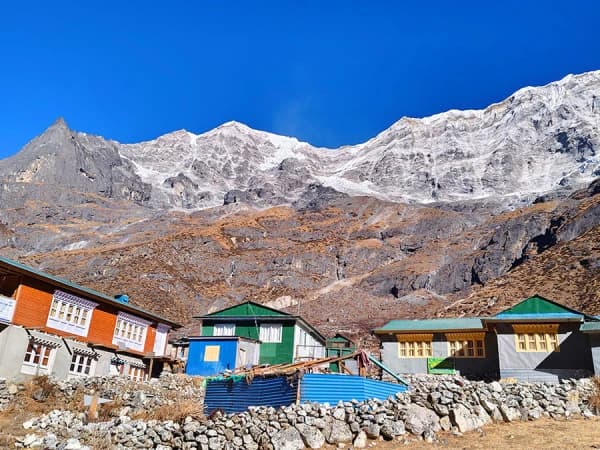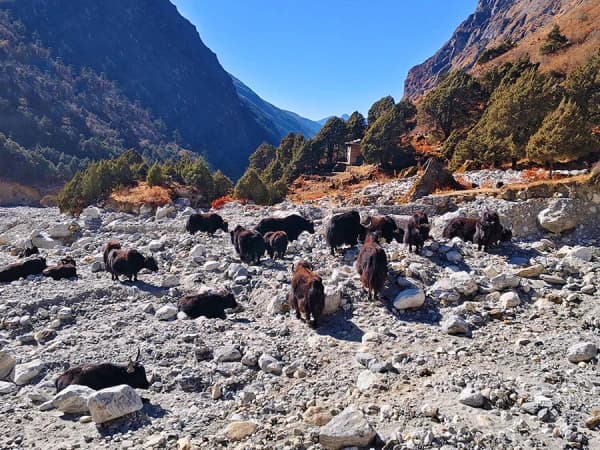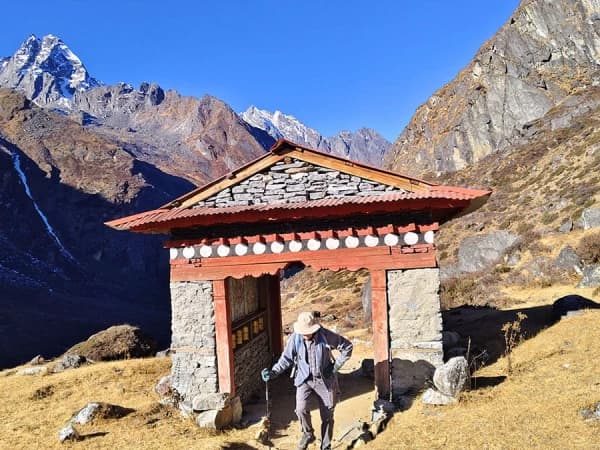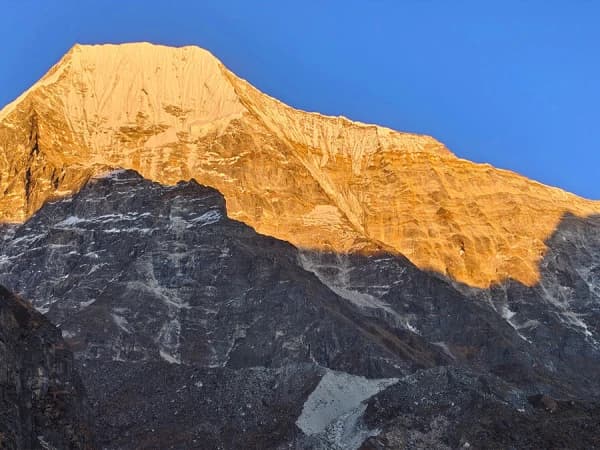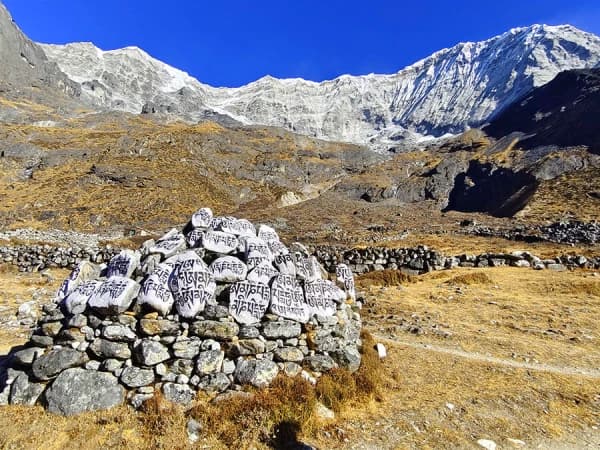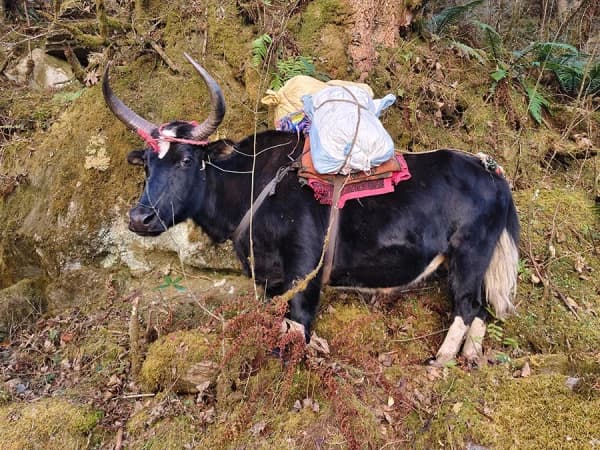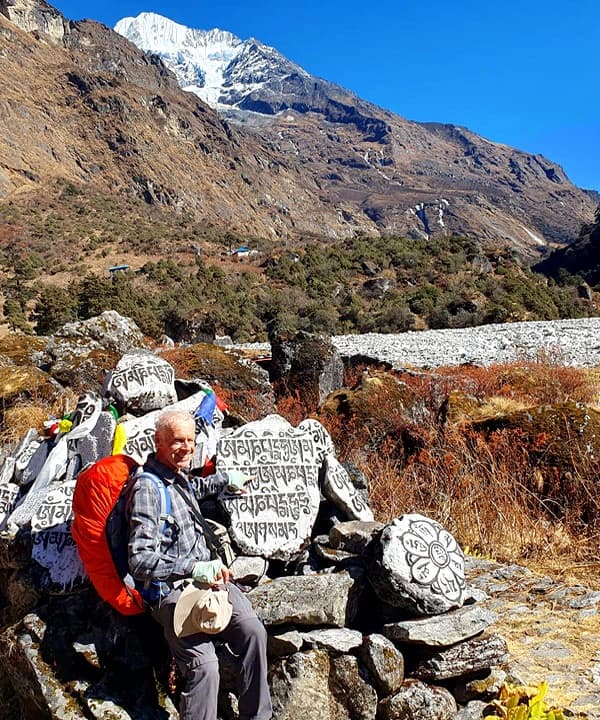The Tsho Rolpa Lake trek in Rolwaling Valley isn’t your run-of-the-mill Himalayan walk. Definitely not; this route sits off the tourist treadmill, wedged between the legendary Langtang and Everest regions.
Tsho Rolpa Lake Trek
Tsho Rolpa Lake Trek is an iconic trek that starts from the Rolwaling Valley, located in Chhetra (at an elevation of 1,500 meters, near Charikot). The journey keeps getting wilder from there, following the Rolwaling River through thick forests. You smell like pine and rhododendron, across high meadows and into glacial valleys where the air’s so crisp it almost bites.
Right from the get-go, after the bumpy drive out of Kathmandu, you’ll land in Chetchet. Then start climbing to Simigaun—classic Sherpa country with killer views of the Gauri Shankar range. The trail snakes upward, ducking in and out of forests thick with rhododendron and pine. If you’re lucky, you will see a massive Himalayan juniper.
Somewhere around Dongang and Beding, you’ll feel like you’ve stepped into a different world: old monasteries. Yaks lumber across the valley, and this broad, glacier-carved landscape makes you feel absolutely tiny.
Now, Beding’s the big village here, but keep heading up, and you’ll hit Na Gaon, a seasonal settlement that feels like it’s hanging on the edge of the sky. From there, it’s a steady grind to Tsho Rolpa Lake, sitting at a lung-busting 4,580 meters. And wow, the lake! It’s this unreal turquoise bowl, wedged under ice cliffs and ringed by peaks like Chekigo, Ramdung Go, and Yalung Ri. If you’re even slightly into photography, you’ll run out of memory cards.
The trek to Tsho Rolpa Lake from Rolwaling Valley is entirely based in the Gaurishankar Conservation Area. This whole trekking route weaves right through it. The Gaurisankar Conservation Area is a total biodiversity hotspot—think red pandas, Himalayan tahr, musk deer skulking around in the underbrush, and more birds than you can shake a trekking pole at.
You’ll spot blue pines, hemlocks, and wild orchids if you’re sharp-eyed, and, come spring, the rhododendrons absolutely explode in color.
Most trekkers double back along the same trail, retracing their steps to Simigaun and Chetchet. The whole loop clocks in at about 65 kilometers—doable in 8 to 10 days, give or take. It’s not Everest-hard, but you’ll feel the altitude, especially after 3,000 meters, so don’t skimp on acclimatization. Teahouses pop up in the bigger villages (Simigaun, Beding, Na), but don’t expect luxury—this is all about the basics.
The real magic of the Rolwaling Valley to Tsho Rolpa Trek lies in its absolute solitude. You’re not going to be tripping over tour groups. Instead, it’s raw nature, quiet villages, and those show-stopping mountain views—Gauri Shankar, Melungtse, and a bunch of Rolwaling peaks you’ve probably never heard of but won’t forget.
Experienced trekkers and adventure seekers sometimes add the Tashi Lapcha Pass to their route, linking up with the Everest region. Still, honestly, even just the valley and the lake are worth the legwork.
All in all, if you want a Himalayan trek that’s big on scenery, wildlife, and old-school Sherpa hospitality—but light on crowds—the Rolwaling Valley to Tsho Rolpa Lake route is a total sleeper hit. Hidden gem, no doubt about it.
The Major Highlights of Tsho Rolpa Lake Trekking in Rolwaling Valley
- Relish the breathtaking beauty of the pristine glacial Tsho Rolpa Lake, set against a dramatic Himalayan backdrop.
- Enjoy exceptional panoramic views of iconic peaks, including Gaurishankar (7,134 m), Melungtse (7,181 m), Dorje Lakpa (6,966 m), Tashi Lapcha Peak, and Yalung Ri.
- Journey through the untouched landscapes of the hidden Rowaling Valley, a lesser-explored region renowned for its natural splendor.
- Immerse yourself in the region’s rich spiritual and cultural heritage by visiting traditional monasteries and ancient chortens along the trail.
- Explore the diverse ecosystems of the Gaurishankar Conservation Area, which is home to a unique array of flora and fauna.
- Witness Tsho Rolpa Lake—the largest glacial lake in Nepal—nestled high in the mountains.
- Encounter rare and elusive wildlife, such as the red panda, Himalayan black bear, snow leopard, and more.
- Delight in an exceptional birdwatching experience, with opportunities to spot Himalayan griffons, lammergeiers, blood pheasants, impeyan pheasants, rufous-bellied tits, and other species.
- Gain a close and authentic insight into Sherpa culture and daily life throughout your trek.
Geographical and Environmental Significance of Tsho Rolpa Lake
Tsho Rolpa Lake is one of the biggest glacial lakes in Nepal. It sits high in the Rolwaling Valley at about 4,580 meters above sea level. The lake is about 3.4 kilometers long and half a kilometer wide. It was formed by melting glaciers, and its clear turquoise water reflects the snow-covered Himalayan mountains around it.
The lake also shows the effects of climate change. As glaciers melt faster, the lake’s water level rises, increasing the risk of floods called glacial lake outburst floods (GLOFs). To reduce this risk, the Nepalese government and other groups monitor water levels, use early warning systems, and control drainage.
Flora and Fauna Along the Tsho Rolpa Lake Trek
The area around the lake is rich in plants and animals suited for the high altitude. In spring and fall, the trails bloom with rhododendron forests—Nepal’s national flower. You’ll also find alpine wildflowers, juniper bushes, and medicinal plants used by locals.
Wildlife includes blue sheep (bharal) on the rocky slopes, the rare snow leopard in higher areas, and birds like the Himalayan monal (Danphe), Nepal’s national bird, plus snow pigeons and vultures.
Cultural Insights: Communities and Traditions in Rolwaling Valley
The Sherpa people have lived in the Rolwaling Valley for many years. Their culture and daily life follow Tibetan Buddhism.
On the trek, you’ll see:
- Bright prayer flags fluttering in the wind
- Mani stones with Buddhist prayers carved into them
- Small monasteries where locals gather to pray
There’s a special festival called Dumji. It’s a dance to honor mountain gods and ancestors. During Dumji, you will notice:
- Colorful costumes
- Masked dances
- Big communal meals
Trekking here isn’t just about the scenery. It’s a chance to meet friendly Sherpa people. When you respect their customs and buy from local shops, you help keep their culture alive.
Itinerary
This is our standard itinerary for the Tsho Rolpa Lake Trek in the Rolwaling Valley.
Upon arrival at Tribhuvan International Airport, a company representative will greet you and escort you to your hotel in Thamel, the vibrant heart of Kathmandu’s tourist district. The remainder of the day is at your leisure. Overnight accommodation is provided in Thamel. Complimentary ground transportation is included.
Depart Kathmandu for Chhetchhet by bus or jeep. Due to ongoing roadworks and repairs caused by the 2024 floods, bus travel currently requires 7–8 hours; a jeep offers a considerably faster option. If bus delays occur, overnight accommodation will be arranged at Chhetchhet.
If time permits, cross the Tama Koshi River by footbridge and ascend the paved stone steps to Simigaon (2.5–3 hours walking). Overnight in a guesthouse or hotel at Simigaon.
Today’s trek leads through enchanting forests of aspen, oak, hemlock, and rhododendron. The trail ascends the valley, passing two picturesque waterfalls, with impressive views of Gauri Shankar (7,135m). Lunch will be taken at Surmuche. Arrive at Dongang, located beside the Rolwaling River.
Due to the 2024 floods, accommodation is currently in comfortable large tents with mattresses and bedding, as the Chekigo Hotel and Restaurant were destroyed. New hotels are under construction. Enjoy the sunset over Chekigo Peak (6,257m).
Sections of the trail have been altered or lost to landslides; the current route is rough and potentially hazardous, especially due to slippery ice from October to April. The path proceeds through beautiful silver pine, hemlock, and rhododendron forests.
At Ramding, cross the khola by suspension bridge, then continue to Beding, a traditional Sherpa village with two Buddhist monasteries. The valley is surrounded by towering peaks.
Proceed along a gently undulating, well-maintained track past the flag-adorned Guru Rinpoche Rock to Na, a small settlement primarily used for summer grazing.
Begin the day early with a hike from Na Village to Tso Rolpa Lake, which takes approximately 2 hours. Cross a suspension bridge over the Rolwaling River and ascend a steep, dry path carved into the hillside. The trail leads between two large glaciers before opening into a broad valley, home to the tranquil Tso Rolpa Lake.
After exploring the glacial lake, follow a rugged path to Dudh Pokhari Lake, situated 120m above Tso Rolpa. Visiting both lakes in a single day is highly recommended for their spiritual and scenic significance. The route traverses alpine grasslands and dwarf rhododendrons to Sangmaklanka, crosses the Rolwaling River, and climbs steeply to Tsho Rolpa at Chukyima (4,500m).
The views are superb, with Tsho Rolpa stretching southeast for 8km and surrounded by high, snow-capped peaks. After visiting the lakes, return to Na for the night.
Retrace your journey through familiar villages to Kyalche. After a 6–7 hour trek, spend the night in Kyalche.
Continue descending; the landscape transforms from arid highlands to lush, green forests. Cross multiple suspension bridges and enjoy the rejuvenated environment as you approach Chhetchhet, where your trek concludes.
After breakfast at the hotel, you will depart for Kathmandu via the same route as your arrival. The journey by bus will take approximately 7 to 8 hours. Upon arrival in Kathmandu, you will be transferred to your hotel for an overnight stay.
At your scheduled flight time, our representative will accompany you to the airport for your departure. We extend our sincere farewell and look forward to welcoming you again in the future.
Dates & Availability
Private tripCost Includes
- All ground transport and complimentary airport pick-up and drop-off.
- Two nights’ accommodation at a three-star category hotel in Kathmandu, including breakfast.
- Three meals a day (breakfast, lunch, and dinner) on the trek.
- All accommodations are in teahouses (twin sharing) during the trek.
- One highly experienced, English-speaking, government-licensed, friendly trekking guide.
- Required porters (1 porter between 2 trekkers). A porter is not included for 1 person.
- Gaurishankar Conservation Area Project (GCAP) permit.
- Tsho Rolpa Trek Map.
- Nepal Gateway Company T-Shirt.
- Nepal Gateway Company duffel bag for trekking.
- Local fresh fruits, which are served as a dessert after your dinner.
- First aid kit with oximeter to check the oxygen level and heartbeats on the trek.
- Evacuation assistance if it is needed.
- Government taxes.
- Office service charge.
Cost Excludes
- Lunches and dinners in Kathmandu.
- Travel Medical Insurance (Compulsory).
- Nepal Visa.
- Your international flight ticket to/from Kathmandu.
- Your personal nature expenses, equipment, and medical kit.
- All kinds of hot drinks (tea/coffee/hot water) on the EBC trek.
- All kinds of cold drinks (water, Fanta, and Coke) and alcoholic beverages during the EBC Trek.
- Hot shower, internet, and phone call unless it is free.
- Battery charging fees for any electronic devices such as cameras, mobile, laptops, etc.
- Snacks and desserts (cakes, pies, chocolate pies, etc.).
- Tipping to field staff (tipping is not mandatory but expected).
- Extra accommodations in Kathmandu.
Good To Know
Cost Breakdown of Tsho Rolpa Lake Trek
The Tsho Rolpa Lake Trek usually costs around US$760 per person. However, the price varies depending on the size of your group, with discounts available for larger groups:
- Solo trekkers pay US$760 each
- Groups of 2 to 4 pay US$700 per person
- Groups of 5 to 10 pay US$660 per person
- Groups of 11 to 16 pay US$620 per person
These discounts help make the trek more affordable for families or friends traveling together.
The fee usually includes permits, a guide and porter, accommodation, basic meals, and transportation to the trailhead. Personal expenses like gear rental, phone charging, tips, and insurance are extra and should be planned for separately.
Best Season for Tsho Rolpa Lake Trek
The Tsho Rolpa Lake Trek is most enjoyable in the spring (March to May) and fall (September to November). Your walk will be more pleasurable during these seasons because of the consistent, bright skies and pleasant temperatures. While autumn brings crisp air and breathtaking vistas of the Himalayan peaks, springtime brings bright rhododendron blossoms that adorn the paths.
Heavy rains in the monsoon season (June to August) can make trails slippery and raise the risk of landslides, so it’s best to avoid trekking then. In winter (December to February), snow can cover higher sections, sometimes closing routes or making hiking tougher.
Difficulty Level of Tsho Rolpa Lake Trek
Tsho Rolpa Lake Trek is moderately challenging to demanding. The highest point is around 4,580 meters, so proper acclimatization is important to avoid altitude sickness. Daily trekking hours range from 4 to 8 hours, often over uneven, rocky, or steep terrain including forest paths, river crossings, and glacier edges.
A good level of fitness and some trekking experience are recommended. Weather at high altitude can be cold and unpredictable, so acclimatization days at Na and near Tsho Rolpa Lake are essential for safety and comfort.
Tips For A Successful Tsho Rolpa Cultural Trek
- Long hours of trekking on varied terrain require physical fitness prior to departure.
- Ascend gradually to allow time for acclimatization and minimize the risk of altitude sickness.
- Stay well-hydrated by consuming a minimum of 3 to 4 liters of water each day.
- Guides are recommended for guidance in navigation, and porters can minimize fatigue.
- Be conscious of the fact that weather in the region is unpredictable and likely to change suddenly; prepare for rain, snow, and sunshine conditions in mind.
- Always seek permission to take pictures of local residents and be respectful in interactions with communities.
Food During The Tsho Rolpa Cultural Trek
The lunch and dinner in the Tsho Rolpa Cultural Trek are nutritious and well-provided, typically carbs, protein, and vegetables. Fresh Nepalese food is provided by all the teahouses on the route. Although the trek is remote, the food for meals is locally produced and fresh. Actually, menu items provided regularly are Dal Bhat Tarkari (lentils, rice, and curry), momo, eggs, porridges, Tibetan bread, noodles, pasta, toast, chapati with tea, etc.
Note: Dal Bhat Tarkari (lentil soup, rice, and curry pickle) is a common Nepali Thali and the main meal of most Nepalese, consumed twice daily. Likewise, every teahouse has this meal, each having a unique combination of vegetables, beans, and spices.
In addition, food is prepared using fresh, locally purchased ingredients. Dal Bhat Tarkari not only consists of balanced calories, but it is also the sole menu item offered unlimited. For a healthy meal, Dal Bhat Tarkari is highly recommended during Tsho Rolpa Trek. There is a popular proverb: "Dal Bhat Power, 24 Hour."
Accommodation During The Tsho Rolpa Cultural Trek
Along the way, accommodation in the remote Rolwaling Valley is tea houses, with a rustic refuge and excellent services, an insight into the local way of life. Tea houses are typically twin-bedded rooms, and washrooms have squat Asian toilets.
Meanwhile, basic amenities such as electricity, Wi-Fi, and hot showers are available, though with decreasing availability at higher altitudes. Likewise, charging for hot showers, Wi-Fi, and battery charging is an additional $2–$3 per use.
Transportation To The Remote Trek to Tsho Rolpa
Tourists should travel to the trailhead by bus prior to the trek. Actually, the journey begins with a bus trip from Kathmandu to Chhetchhet, lasting seven hours. In fact, the travel is scenic as one experiences landscapes, fields, and vibrant rural markets during the route. While the ride is generally smooth, certain routes may be rough due to road conditions.
Alternatively, trekkers can rent a private jeep at an additional cost. Based on 25 years of experience in trekking, a private jeep would be recommended for a luxurious and value-for-money Himalayan travel experience. The cost of a private jeep is normally $200 per way.
Internet, Telephone, And Battery Charging During The Tsho Rolpa Lake Expedition
Electricity, Wi-Fi, and mobile phone charging points are available at lower levels, though not in many cases as height increases. Likewise, internet connectivity is bad and is typically only accessible in some villages. NCELL and NTC SIM card mobile receptions are typically available in large villages, but the coverage is lower at higher altitudes.
Battery charging is usually available at lower rates, even within a room at times; charging stations are usually available in communal spaces at high altitudes. Actually, there is a nominal fee for charging the devices. Carrying a power bank or extra battery is recommended.
Insurance
Before departing on the Tsho Rolpa Lake Expedition, it is wise to acquire a full-travel coverage insurance policy so that you can travel with peace of mind. Due to the rugged and remote nature of the trek, insurance will cover you against any unexpected expenses like medical issues, evacuation, or trip cancellation.
Actually, it is advisable to select an insurance plan that specifically includes high-altitude activities and emergency helicopter evacuation coverage. Furthermore, verify that your policy provides coverage at high elevations and offers upfront payment for claims rather than reimbursement after the fact.
Porter
For the Tsho Rolpa High Altitude Trek, employment of a porter is a reasonable option, as it significantly lowers the physical burden of trekking. Often, there is one porter per two and can handle 20 kg of gear. In fact, Employment of a porter makes trekking more comfortable.
Nepal Gateway Trekking Experts recommend hiring a local porter because they are fully aware of the path and the region in general. In addition, local porters can offer you valuable advice on your trekking tour.
Additionally, hiring a porter directly contributes to the benefit of the local people and economy. Should you desire assistance in locating an experienced, local porter, Nepal Gateway Trekking Experts are willing to help.
Trekking Equipment for Tsho Rolpa High Altitude Trek
In order to be able to travel safely over the rough terrain of the Tsho Rolpa High Altitude Trek, the right equipment is essential. The season will determine the need for extra warm clothing.
Selling out and splurging for good gear and clothing will not only keep you safer but also allow you to properly enjoy the natural beauty of the Rolwaling Valley.
Clothing
- Inner thermals
- Wind and waterproof jacket and trousers
- Waterproof pants
- Lightweight, quick-drying trekking pants
- Shorts
- Underwear
- Gloves
- Moisture-wicking, quick-drying trekking socks
- Muffler or scarf
- Gaiters (optional, depending on the season)
- Sandals
- Good-quality trekking boots
Other Gear
- Sun hat
- Sun spectacles
- Sunscreen
- Lip balm
- Wet wipes
- Soap bar
- Female hygiene
- First-aid kit
- Adapter
- Power bank
- Camera
- Water bottle
- Trekking poles
- Towel
- Sanitizer
Nepalese Money and Payment
The rupee is the national currency in Nepal. The best currencies to exchange are the US dollar, Australian dollar, British pound, Canadian dollar, Singapore dollar, and the euro, which can be exchanged with ease in Kathmandu or Pokhara.
Actually, major credit cards such as Visa, MasterCard, and American Express are accepted by tourist-class hotels, restaurants, airlines, and major shops in Kathmandu, Bhaktapur, Patan, and Pokhara. A surcharge of approximately 3.5% is normally levied on all card transactions.
Likewise, ATMs are plentiful in Kathmandu and Pokhara, particularly in the Thamel district. Some ATMs have a withdrawal limit of Rs 10,000 a day, while others offer up to Rs 35,000. An additional charge of USD 5 is commonly levied per transaction, in addition to any fee your bank may impose.
On-Arrival Visa in Nepal
When you actually do arrive in Nepal, you can obtain a visa upon entry at Tribhuvan International Airport in Kathmandu or choose to apply in advance through a Nepalese embassy or consulate in your home country. You can also obtain visas at the following border crossings on land: Birgunj, Kakarbhitta, Bhairawa, Belhiya, Nepalgunj, Dhangadi, Mahendranagar, and the Kodari Pass from Tibet.
Actually, it is advisable to keep cash in the below-mentioned currencies to pay for a visa: US dollars, euros, Swiss francs, British pounds, Australian dollars, Canadian dollars, Hong Kong dollars, Singapore dollars, or Japanese yen. Payment with a credit card is also accepted nowadays.
As per the latest information, visa fees are as below:
- Multiple entries for 15 days: USD 30 or its equivalent
- Multiple entries for 30 days: USD 50 or its equivalent
- Multiple entry for 90 days: USD 125 or equivalent
Passports must be valid for at least six months. Visas can be extended from Nepal Immigration offices in Kathmandu and Pokhara. For further information, please check the Nepal Immigration website or call us directly.
FAQs
Yes, trekkers must obtain a Restricted Area Permit and a Gaurishankar Conservation Area Permit before starting the trek.
The highest point on the Tsho Rolpa Lake Trek is around 4,580 meters, right at the lake itself.
Basic teahouses and camping areas are available as lodging choices, offering hikers the amenities they need.
This trek is best suited for those with prior trekking experience and good physical fitness due to high altitude and challenging terrain.
Spring (March to May) and autumn (September to December) are the best seasons, offering stable weather and clear views.
Yes, hiring experienced guides and porters is recommended and can be arranged through trekking agencies.
Bring warm clothing suitable for cold weather, sturdy trekking boots, trekking poles, a sleeping bag, and any necessary personal medication.
The trek usually starts from Chhetchhet or Shigati, accessible by jeep or bus from Kathmandu with a 7 to 9-hour drive.
Simple Nepali meals and some international options are available at teahouses. It’s good to carry snacks and energy bars for long trekking days.
Mobile and internet connectivity is limited and often unreliable, so prepare for offline communication.
Traveler’s Experience with Us?
I have been trekking with Nepal Gateway Trekking to Rolwaling Valley and Tsho Rolpa, a glacial lake sacred to Hindus and situated at 4580 m...
